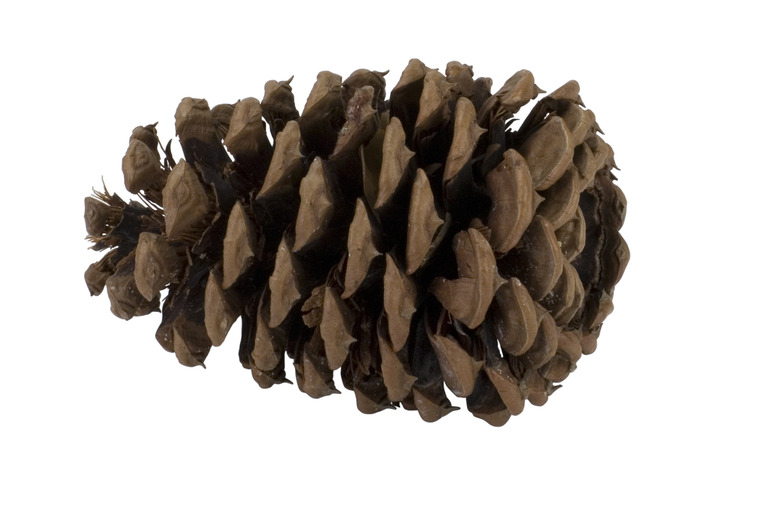Stages Of A Pine Cone
Pine cones are not just things we pick up from the ground that are good for crafts, making fires and playing with the dog. Pine cones are actually the seed pods for pine trees in the Pinaceae family.
Pine trees are found in a group of trees called _gymnosperms_, which have naked seeds, unlike angiosperms whose seeds grow in fruits. Pine cones help protect the otherwise naked seeds.
Life Cycle of a Pine Tree
Life Cycle of a Pine Tree
Like all vascular plants, a pine tree starts from a fertilized seed. When the seed is in the right soil conditions, it begins to grow.
Once a pine tree reaches sexual maturity, it grows separate male and female reproductive parts called strobili (singular: strobilus). The male strobilus grows pollen and releases it into the wind where it lands on the female strobili of neighboring trees to create new pine seeds.
The Female Strobilus
The Female Strobilus
Pine cone development starts with the female strobilus. The female's strobilus is larger than the male's.
It is formed from modified leaf structures that spiral around a central axis, forming scale-type structures. Each scale has two ovules awaiting pollination.
Pine Pollination
Pine Pollination
When the pollen is released from the male strobilus, it is transported by the wind to the female strobilus of other pine trees of the same species. The pollen sticks to the fluid in a structure called the micropyle, which leads to the nucellus of the ovule. The micropyle fluids evaporate, drawing the pollen grain closer to the ovule. This action stimulates the pollen grain to develop a pollen tube.
Before the sperm from the pollen grain make it to the ovules, the female produces four cells called megaspores. Only one of these megaspores survives and develops into a multicellular megagametophyte. The megagametophyte then grows archegonia, which contain egg cells.
Pine Fertilization
Pine Fertilization
The archegonia take a year to develop after the pollen grain first lands on the female strobilus. The pollen tube can now reach the female egg cells to deliver the sperm.
The pollen grain sends two sperm to the egg cell, one of which fertilizes the egg, creating a zygote.
Pine Seed Development
Pine Seed Development
The zygote is diploid, meaning it has two sets of chromosomes, one from the mother and one from the father. As the zygote develops, it forms the pine seed.
Pine seeds contain the embryos needed to grow new pine trees. It can take two or three years after fertilization before the embryo is fully developed.
Pine Cone Growth
Pine Cone Growth
The pine cone life cycle starts with a group of female strobili, called an inflorescence. Inside the scales, the seeds develop next to each other in the inflorescence.
The pine cone grows as the seeds inside grow, protecting them from predators and harsh weather along the way. When the weather is warm enough, the scales of the pine cone pop open, releasing the seeds.
Jack Pine Ecosystem
Jack Pine Ecosystem
Jack pine (Pinus banksiana) is adapted to hot, dry environments that are prone to fire. While most pine cones release their seeds when the weather is warm and the soil is moist enough for germination, the Jack pine has a more dramatic tact: it needs that fire.
The Jack pine has adapted to fire so well that it needs wildfires to trigger the release of its seeds. The seeds then develop in the soil freshly cleared of other plant life.
Edible Pine Seeds
Edible Pine Seeds
Twenty species of pine produce pine seeds big enough for humans to harvest and eat. The seeds are a light brown or yellow color and can be up to 2 inches (5 centimeters) around.
Pine seeds, or pine nuts, are very nutritious and contain vitamins B1, K, magnesium, manganese, phosphorus, zinc and protein.
References
- Brazilian Archives of Biology and Technology: Development and Growth Curve of the Pine Cones of Araucaria angustifolia (Bert.) O. Ktze, in the Region of Curitiba – PR
- Jrank.org: Pines – Life Cycle
- Encyclopaedia Britannica: Gymnosperm
- U.S. Forest Service: Pinus Banksiana
- Michigan Department of Natural Resources: Jack Pine
- ThoughtCo: 13 Most Common North American Pine Species
- Michigan State University Extension: Fun Facts About Pine Cones
- Radboud University Nijmegen: Life Cycle of the Pine Tree (Gymnosperm)
Cite This Article
MLA
Jerrett, Adrianne. "Stages Of A Pine Cone" sciencing.com, https://www.sciencing.com/stages-pine-cone-10012522/. 15 July 2019.
APA
Jerrett, Adrianne. (2019, July 15). Stages Of A Pine Cone. sciencing.com. Retrieved from https://www.sciencing.com/stages-pine-cone-10012522/
Chicago
Jerrett, Adrianne. Stages Of A Pine Cone last modified March 24, 2022. https://www.sciencing.com/stages-pine-cone-10012522/
